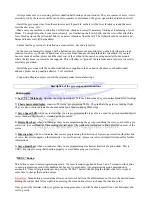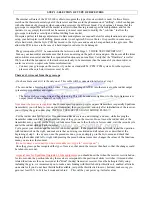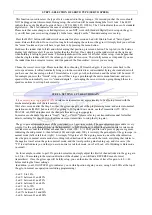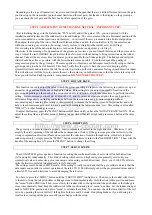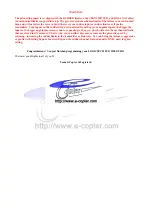
– Always make sure you are using perfect condition ball bearings on your models They are sources of noise / static
electricity, while the receiver will be much more sensitive to disturbance, the gyroscope could be disturbed as well.
- Install the gyroscope close from the main rotor axis if possible, as there will be less vibrations around the main
mast than far away of it.
- Make sure your machine is setup free of vibrations, check and correct if necessary tracking and balancing of your
blades. You might also check your main rotor axis, your feathering shaft, tail shaftr, and the screws that attach the
feet of blade grips on the tail central hub if you detect vibrations from the tail. The flybarl should be centered and
balanced if necessary (flybar paddles).
- Ensure that the gyroscope is installed on a clean surface, dry and grease free.
- In the case your model is equipped with a belt driven tail, please use graphite spray on the belt (Operation to be
renewed renew every 2 hours of operation) if you see abrupt changes or unexplained tail orientation. If your tail
boom is made of carbon, please sand the clear coat of the carbon tail boom when using metal tail boom mounts
where the tail boom is pressed by the supports. This will allow to “ground” the tail boom and avoid excessive static
electricity generation.
- Install the gyroscope with the double-sided adhesive supplied in the box and in the absence of double-sided
adhesive please use top quality adhesive, 2 or 3mm thick .
- Connection Diagram: please consult the original product manual drawings.
Description of the gyroscope and its functions
LEDs display
:
1)
Led "TL" (Tail Lock)
: whether or not the operation is Tail Lock (led turned on) or in normal mode (led flashing).
2)
8 Leds horizontal display
: consists of 8 status / programming LEDs. They indicate the gain level during flight.
They are also used to indicate the choosen value for a function during these steps
3)
Servo Speed LED
: when on, indicate that you are programming the type of servo used (Logictech matched digital
servo, Standard Digital servo , standard analogic servo) .
4)
Rotate Rate Led
: when on, indicates that you are programming the gyro for matching the servo speed to the gyro
correction to avoid bounces when making fast tail stops. The rotate rate is often set on 2nd or 3rd led on most of the
servos.
5)
Direction Led
: when on, indicates that you are programming the direction of Gyroscope correction (the direction
of servo travel is managed on the transmitter –reverse function- , please consult your transmitter manual for further
informations.
6)
Servo Limit Led
: when on, indicates that you are programming mechanical limits of the pitch slider. This is
VERY important to setup that function properly to avoid damaging your tail servo.
"MENU" button
:
This button is used to enter programming mode. We must remain supported between 3 and 5 seconds on the button
to enter programming mode (this deadline has been set to avoid entry into programming mode unintended or
accidental). Once in programming mode, press the "MENU" button with keeping the rudder stick left or right at
same time to change the function values.
Remember
: Menu button pressed alone allows you to switch between the different menus. Once in the desired menu,
holding the rudder stick left or right when pressing the menu button allows to change the function value.
Once you will be familiar with your gyroscope setup procedure, you will be able to install it on your helicopter and
set it up easily


